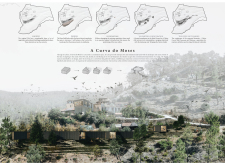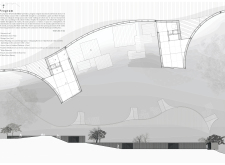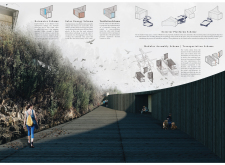5 key facts about this project
The cabins are thoughtfully arranged along a continuous curved path, which connects the structures while allowing for individual experiences. This layout not only fosters community and interaction among users but also engages with the topography of the site. The architecture maintains a visual connection to the landscape, featuring large windows that frame views of the surrounding area, enhancing the sensory experience of the occupants.
Sustainable architecture is central to "A Curva do Moses." The design includes features such as rainwater harvesting systems and photovoltaic panels, enabling the cabins to operate with minimal environmental impact. Additionally, the use of natural materials, primarily wood, reinforces the project’s commitment to ecology while ensuring durability and aesthetic coherence.
The unique design approaches of this project include the integration of organic forms and the emphasis on user experience. The curved design of the walls serves not only as a visual element but also as a means of guiding movement within and between the cabins. This focus on flow and continuity contrasts with conventional cabin designs that often prioritize rectangular forms, promoting a more harmonious interaction with the landscape.
The cabins' platforms extend outward, providing outdoor spaces for relaxation and meditation. They are strategically positioned to maximize exposure to natural sunlight, creating inviting areas for users to gather or reflect. The cabins are anchored on a podium that minimizes disturbance to the natural terrain while ensuring structural stability and accessibility.
In analyzing the various architectural elements, the project utilizes specific materials effectively. The predominant use of wooden structures allows for a warm, organic feel, while the incorporation of insulated concrete within the foundations provides necessary stability. The exterior is clad with black wooden slats, creating a visual contrast with the vibrant greenery of the surroundings.
For those interested in exploring the details further, reviewing the architectural plans, sections, designs, and ideas behind "A Curva do Moses" will provide deeper insights into its thoughtful execution and how it contributes to contemporary architecture focused on sustainability and connection with nature. This project embodies a modern understanding of design that harmonizes built environments with their natural contexts, making a case for responsible architectural practices today.


























